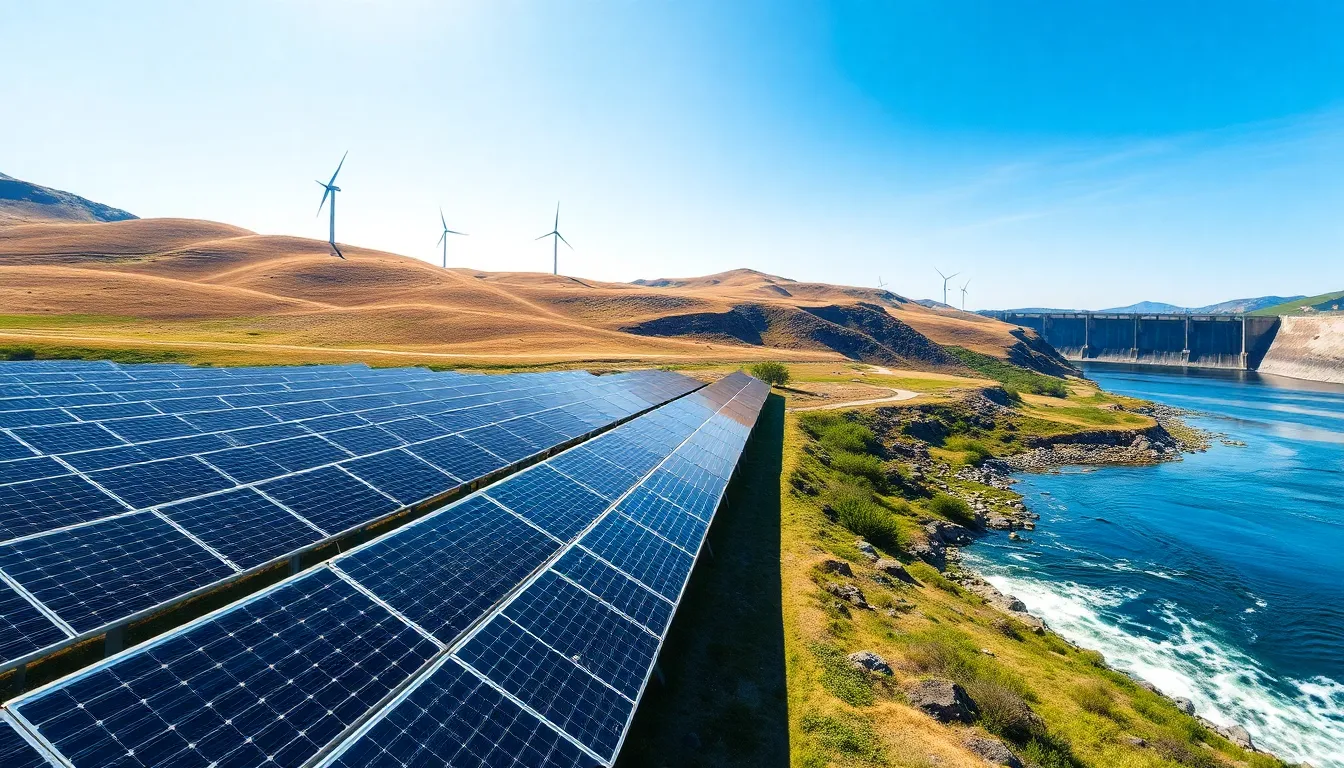Table of Contents
ToggleIn a world where the sun shines brighter than your neighbor’s new SUV, sustainable energy technology is stepping into the spotlight. Forget fossil fuels and their dramatic carbon footprint; it’s time to embrace solutions that not only power homes but also save the planet. From wind turbines that dance with the breeze to solar panels soaking up the sun like a beachgoer on vacation, these innovations are here to stay.
Overview of Sustainable Energy Technology
Sustainable energy technology includes renewable sources such as solar, wind, and geothermal energy. Innovations in these areas significantly reduce reliance on fossil fuels. Solar panels capture sunlight and convert it into electricity, making them a popular choice for both residential and commercial spaces. Wind turbines harness wind power, generating energy with minimal emissions and land use.
Geothermal energy utilizes heat from the Earth’s interior, providing a consistent energy supply. This technology often ensures low operational costs and minimal environmental impact. Biomass energy, derived from organic materials, also plays a key role in sustainable energy solutions. It transforms waste into usable energy, mitigating landfill concerns and promoting resource efficiency.
Energy storage systems, including batteries, enhance the effectiveness of renewable sources. These systems store energy generated during peak production, allowing for use during low production periods. Advances in battery technology are vital for improving sustainability efforts, ensuring energy availability and reliability.
Smart grids optimize energy distribution, integrating various energy sources efficiently. They utilize real-time data to balance supply and demand, increasing reliability while reducing waste. Electric vehicles represent another facet of sustainable energy technology, as they rely on cleaner energy sources, further diminishing carbon footprints.
Government policies and incentives support the transition to sustainable energy technologies. By prioritizing research and development, nations advance their energy systems towards greater sustainability. Overall, the landscape of sustainable energy technology continues to evolve, focusing on environmental health and fostering economic growth.
Types of Sustainable Energy Technologies

Various sustainable energy technologies play a crucial role in mitigating climate change and advancing ecological stability. Here are some key technologies driving the transition away from fossil fuels.
Solar Energy
Solar energy harnesses sunlight for electricity generation. The technology includes photovoltaic panels that convert light into usable power. Innovations in solar thermal systems capture heat for heating and cooling applications. Solar farms produce ample energy, contributing to grid support. The cost of solar installations has significantly decreased, making them accessible for households and businesses alike.
Wind Energy
Wind energy relies on turbines that capture kinetic energy from wind. Turbines convert wind flow into electricity, contributing to substantial emissions reductions. Onshore wind farms are more common, but offshore installations offer the potential for increased capacity. Countries with favorable wind conditions see significant investments in this technology. Turbine advancements enhance efficiency and lifespan, making wind energy more competitive.
Hydropower
Hydropower captures energy from flowing water, primarily through dams or run-of-river systems. The energy production process involves converting the motion of water into electricity. It accounts for about 16% of global energy generation. Sustainable management practices enhance its long-term reliability and ecosystem health. Seasonal fluctuations impact energy supply, necessitating adaptive management strategies.
Biomass
Biomass energy transforms organic materials into usable energy forms. This includes agricultural residues, wood, and dedicated energy crops. Conversion methods such as combustion and anaerobic digestion produce electricity and heat. Biomass reduces landfill waste, simultaneously addressing energy challenges. When sourced sustainably, biomass can significantly lower carbon footprints compared to fossil fuels.
Geothermal Energy
Geothermal energy utilizes heat from the Earth’s core. It provides a consistent and reliable energy source, with low operational costs. Geothermal plants convert steam and hot water into electricity, contributing significantly to the grid. Direct use applications include heating buildings and greenhouses. Suitable locations for geothermal energy enhance its viability and economic potential.
Benefits of Sustainable Energy Technology
Sustainable energy technology provides numerous benefits that influence the environment, economy, and energy security positively.
Environmental Impact
Sustainable energy technology significantly lowers greenhouse gas emissions. Transitioning to renewable sources reduces reliance on fossil fuels, which contributes to climate change. Wind and solar energy produce electricity without emitting carbon dioxide. Furthermore, utilizing biomass energy transforms waste into energy, decreasing landfill burdens. Significant reductions in air pollution come from adopting clean energy solutions, leading to healthier ecosystems and communities. Sustainable practices also support biodiversity conservation by minimizing habitat destruction compared to traditional energy extraction methods.
Economic Advantages
Economic growth is another key benefit associated with sustainable energy technology. Investment in renewable technologies creates jobs, ranging from manufacturing to installation and maintenance. In 2021, solar and wind industries collectively employed over 500,000 individuals in the U.S. Lower energy costs emerge from increased efficiency and the decreasing prices of renewable energy systems. Homeowners save money on energy bills by adopting solar panels. Additionally, governments and businesses save on health-related expenses due to improved air quality resulting from cleaner energy sources.
Energy Security
Energy security increases through the adoption of sustainable energy technology. Renewable sources reduce dependence on imported fuels, which enhances national security. Countries benefit from in-state energy production, diminishing vulnerability to global supply disruptions. Diverse energy portfolios incorporating solar, wind, and other renewable sources allow for more stable energy pricing. Moreover, energy storage advancements enable reliable access to power, even during outages. Integrating smart grids facilitates efficient energy distribution, addressing peaks in demand and ensuring uninterrupted supply.
Challenges Facing Sustainable Energy Technology
Sustainable energy technology faces multiple challenges that hinder widespread adoption. Addressing these challenges is essential for advancing renewable sources and their implementation.
Initial Costs
Initial costs pose a significant barrier to adopting renewable energy systems. Installing solar panels and wind turbines often requires substantial upfront investment, which can deter individuals and businesses from making the switch. Financial incentives, such as tax credits and rebates, can alleviate some of these expenses, yet not all regions provide equal support. Over time, decreasing installation costs improve accessibility, but the initial price remains a challenge.
Technological Limitations
Technological limitations hinder the efficiency and reliability of sustainable energy solutions. Energy storage systems, such as batteries, struggle with capacity and longevity, affecting the ability to utilize captured energy effectively. Solar and wind energy production remains intermittent, reliant on optimal weather conditions. Moreover, some renewable technologies still require further research to enhance efficiency and lower costs. As advancements continue, overcoming these limitations becomes crucial for increased adoption and effectiveness.
Policy and Regulatory Hurdles
Policy and regulatory hurdles create obstacles for sustainable energy technology implementation. Inconsistent regulations across regions make it difficult for companies to navigate the legal landscape. Incentives vary, affecting investment and development rates. Striking a balance between environmental goals and economic interests is vital for policy-makers. Clear policies that promote renewable energy can lead to accelerated growth in this sector. Improving regulatory frameworks ensures sustainable energy technologies achieve their full potential.
Future Trends in Sustainable Energy Technology
Sustainable energy technology is on the brink of exciting developments that promise to shape the future. As innovation continues, both new materials and methods will drive efficiency and accessibility.
Innovations on the Horizon
Advancements in wave energy converters show significant potential for harnessing ocean energy, with devices capable of capturing energy from sea waves. The emergence of perovskite solar cells offers a promise of higher efficiency rates at lower production costs. Enhanced energy storage solutions, such as solid-state batteries, stand ready to revolutionize energy efficiency by increasing capacity while reducing safety risks. Moreover, advances in hydrogen production through electrolysis are creating pathways for cleaner fuel alternatives. As technology evolves, integrating these innovations into existing infrastructures could accelerate the worldwide transition to sustainable energy sources.
Role of Artificial Intelligence
Artificial intelligence (AI) plays a critical role in optimizing energy consumption and enhancing grid management. Through predictive analytics, AI can forecast energy demand, ensuring efficient resource allocation. Machine learning algorithms analyze vast data sets to identify patterns that improve energy efficiency, enabling smarter grids with real-time adjustments. AI-driven applications assist in monitoring renewable energy systems, leading to proactive maintenance and increased operational reliability. As AI continues to integrate into sustainable technologies, it streamlines processes and supports strategic decision-making for a greener future.
Sustainable energy technology is reshaping the way society approaches energy consumption and production. By harnessing renewable resources and integrating innovative solutions, it paves the way for a cleaner and more sustainable future. The ongoing advancements in solar, wind, geothermal, and biomass energy demonstrate the potential to meet growing energy demands while minimizing environmental impact.
As the challenges of initial costs and regulatory hurdles are addressed, the transition to sustainable energy will become more feasible. The incorporation of smart grids and advanced energy storage systems will further enhance efficiency and reliability. With a commitment to research and development, the promise of sustainable energy technology holds the key to a healthier planet and a robust economy for generations to come.







